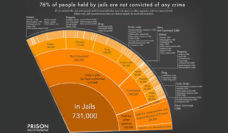Parole for those who are incarcerated for a violent crime should rest on the answer to one question: Is this person likely to reoffend after release? To guide parole board decisions, clinicians use historical information about the person who is up for parole, like the number of times this person has been incarcerated and the number and types of criminal arrests. However, the types of questions clinicians ask are based on research conducted almost exclusively with men, despite differences in criminal activity between men and women.
Women are incarcerated for violent crimes less often than men, and the types of violent crimes men and women commit depends on whom they are assaulting and their relationship to the victim. For example, women are more likely than men to assault family and friends. When we look at the percentages of all homicides of children less than 5 years old that are perpetrated by acquaintances, a different story emerges. Male acquaintances are responsible for 23% of all homicides of children under age 5, compared to 5% of female acquaintances. Mental health challenges also contribute differently to men’s and women’s criminal activity. Some men committing acts of violence have borderline personality disorder and substance use disorder, but such diagnoses are rarer among women offenders.
Given these results, Britt and her team concluded that the IVVI is very useful for predicting future violent crimes perpetrated by both men and women and might represent a valuable new option for clinicians assessing risk of reoffense.
Is it appropriate to determine parole eligibility for women based on a questionnaire designed for men? Clinicians in Iowa in 2016 developed a questionnaire to help estimate future crime risk called the Iowa Violence and Victimization Instrument (IVVI). The IVVI demonstrated an ability to predict violence after release for parole or probation, but the questionnaire was tested only with men. Jessica Britt and her team wanted to know if the questionnaire performs similarly for women two years after release for parole.
Women in this study reoffended much less often than the men who were assessed in the initial study of the IVVI. However, for those the questionnaire identified as “high risk” for re-offense, both men and women exhibited similar rates of violence and felony property offenses. Both men and women with a history of multiple convictions and gang membership were equally likely to reoffend. However, the questionnaire was less effective at identifying differences in risk for re-offense for misdemeanor crimes like drug offenses and property offenses less than $1,000.
Given these results, Britt and her team concluded that the IVVI is very useful for predicting future violent crimes perpetrated by both men and women and might represent a valuable new option for clinicians assessing risk of reoffense. They noted that the ability of the IVVI to predict these crimes is likely due to the impulsive and aggressive behaviors that might lead someone to commit riskier offenses. They speculated that the IVVI is less powerful at predicting other crimes for women because the motive to commit a violent crime is different from the motive to commit a crime like a drug offense.
If you or someone you know are experiencing domestic violence, call the National Domestic Violence Hotline at 1-800-799-7233 or visit thehotline.org for support and resources.
Photo via Getty Images














